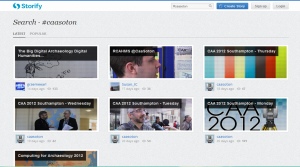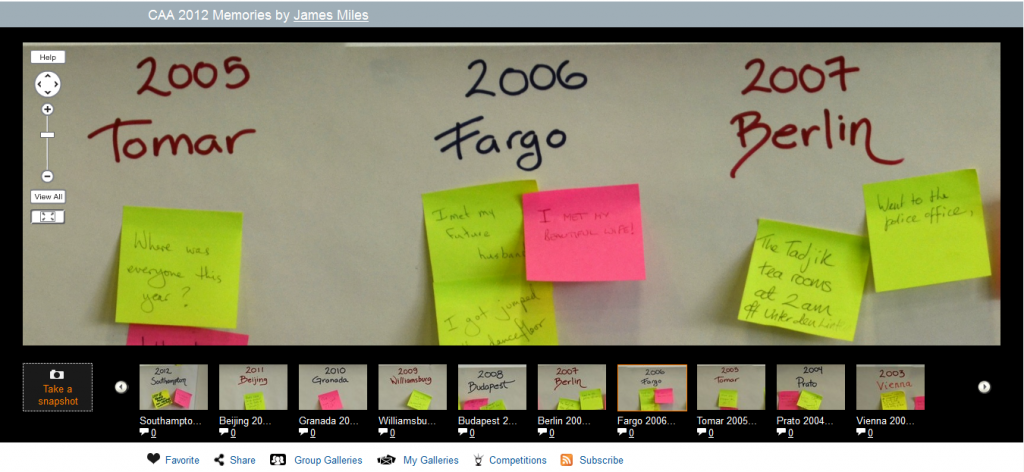We’ve been scouring the web to bring you some of the best CAA2012 content from delegates. Here are some highlights:
CAA2012 on Storify
There are multiple great Storifies (is that the plural?!) that delegates have created showcasing their favourite CAA2012 moments.
CAA2012 on Twitter
There are now just under 12,000 tweets in the #caasoton archive! We’ve been collecting them,and will make them available as an archive soon.
CAA2012 on del.icio.us
Those 12,000 tweets included alot of web links. The archive will be available soon, but in the meantime, we’ve automatically put all of the URLs from the tweets into a del.icio.us account, so that you can look through and visit any useful websites. Ultimately, we’d like to organise these into papers/sessions, so any suggestions on how to go about this will be much appreciated!

We’ve created CAA2012 Session stacks in del.icio.us to put the hundreds of URLs from twitter into, as we gradually curate them.
CAA Personal Memories Gigapan
James Miles, of the Archaeological Computing Research Group, University of Southampton, has created an interactive timeline using the memories that you shared with us at the CAA2012.
The timeline uses Gigapan software to compile a series of photographs that James took to record the giant timeline that you may remember seeing at the conference.
You can add comments to the timeline, and also upload your own snapshots; so please do join in with collecting the Personal Histories of the CAA!
By far and away, the most exciting development for us, has been the willingness of paper authors to share their presentations. There are already a few presentations available on slideshare, and we hope to see many more being uploaded over the next few weeks.
They’re proving quite tricky to track down so, if you add your paper presentation on slideshare, please let us know so that we can link to it here to broaden its reach.
If you are planning on adding your presentation to slideshare, please tag it with ‘caasoton’ so that we can find it!
Here are some of the presentations that we have found so far (I’ve tracked down 18 presentations, but I am sure that there are more), in no particular order:
Orla Murphy, Digital Humanities
J. Andrew Dufton and Stuart Eve, Guerrilla Foursquare: A digital archaeological appropriation of commercial location-based social networking
Dan Boddice, Using Time Domain Reflectometry (TDR) to Monitor the Geophysical Properties of Archaeological Residues
Ethan Gruber, Linking Roman Coins: Current Work at the American Numismatic Society
Lev Manovich, Session Introduction: Visualization as a Method in Art History
Gareth Beale and Nicole Beale, Re-reading the British Memorial. A Community Church Documentation Project
Yasuhisa Kondo and Takayuki Ako, “TOMOBIKI Night” A Japanese Archaeo-GIS Ustream programme
Koan Van Daele, Imperfect Temporal Information in Data Sets
Anthony Beck, Andrew Bevan, Stefano Costa, What does the Holy Grail look like? Defining open data in archaeology and the related issues
Susan Casey, Rebecca Jones, Peter McKeague, Old Places, New Ideas. New Routes into Canmore, the National Inventory of Scotland
Jess Ogden, Stuart Eve, Andrew Dufton, The Archaeological Recording Kit: An open source solution to project recording
Jess Ogden, Stuart Eve, Guy Hunt, Fasti & Furious: (re)Introducing FASTI Online
David Stott, Seeing the unseen: Improving aerial prospection outside the visible spectrum
Dan Boddice, Using Time Domain Reflectometry (TDR) to Monitor the Geophysical Properties of Archaeological Residues
Nevio Dubbini and Gabriele Gattiglia, Mathematical models for the determination of archaeological potential
Peter McKeague and Mike Middleton, Beyond INSPIRE: Towards delivering richer heritage data in Scotland
Lawrence Shaw, “There’s an App for That”: How can smartphones improve the ergonomics of landsape study, analysis and
interpretation?
CAA2012 Blog posts
There are a few posts providing really useful overviews of the CAA2012. Here are a few of my favourites:
Lisa Harris, 31st March 2012, SMiLE: Early Reflections and Next Steps
Gary Nobles, 1st April 2012, CAA 2012 Southampton
Kathryn Piquette, 4th April 2012, Visualising ancient Egyptian artefact surface transformations
Orla Murphy, 27th March 2012, Report on March 26th Plenary at CAA Southampton 2012 by Jeremy Huggett
Madeline Paterson, 29th March 2012, From Twitter sceptic to full-on convert (YouTube video)
Stuart Dunn, 1st April 2012, CAA1 – The Digital Humanities and Archaeology Venn Diagram
Steve Hitchcock, 29th March 2012, DataPool: presented, tweeted, blogged
CAA2012 on Vimeo
I know you may have seen some of these before, but I had to include again a link to the fantastic Vimeo videos, created by SUSUtv. We now have 11 videos, so visit the caaconference Vimeo channel to see them all.
CAA Social Media in Live Events (SMiLE) project
The SMiLE team have been working hard to spread the social media word, and have presented a few papers on different aspects of the project. Here are a few highlights for you to take a look at:
Beale, N., Ogden, J., 2012. Social Media at the CAA – A Reflective Report, Internet Archaeology Journal, Sept. 2012, 32: http://intarch.ac.uk/journal/issue32/
Front page of Research Councils UK Digital Economy news: http://www.rcuk.ac.uk/research/xrcprogrammes/Digital/updates/Pages/120725SMiLE.aspx
Beale, N., Earl, G., Harris, L. 2012. Tools and tips to bridge and enhance live events, Smart Insights, 11th July 2012, http://www.smartinsights.com/social-media-marketing/social-media-strategy/new-research-reveals-effective-integration-of-livevirtual-event-experiences/#utm_source=twitterfeed&utm_medium=social-media&utm_campaign=SmartInsights
Harris, L., Earl, G., Beale, N., Phethean, C., Brughmans, T., 2012. Building Personal Learning Networks through Event- Based Social Media: a Case Study of the SMiLE Project, PLE Conference Proceedings, PLE Conference 2012, http://revistas.ua.pt/index.php/ple/article/view/1444
Harris, L., Beale, N., 2012. If you don’t have social media, you are no one: How social media enriches conferences for some but risks isolating others, London School of Economics and Political Science, Impact of Social Sciences, 23rd May 2012, http://blogs.lse.ac.uk/impactofsocialsciences/2012/05/23/social-media-enrich-but-isolate/
Beale, N., Harris, L., 2012. “But who is going to read 12,000 tweets?!” How researchers can collect and share relevant social media content at conferences, London School of Economics and Political Science, Impact of Social Sciences, 25th June 2012, http://blogs.lse.ac.uk/impactofsocialsciences/2012/06/25/smile-archive-visualise-tweets-conference/
Beale, N., Harris, L., 2012. Social Media in Live Events (SMiLE) project, paper presented at the Digital Literacies Conference, University of Southampton, June 2012 (http://caaconference.org/caa2012/). http://www.slideshare.net/nicoleebeale/smile-project-digital-literacies-conference-caasoton-sotonde
Beale, N., 2012. Social Media in Live Events (SMiLE) project, poster presented at the Digital Literacies Conference, University of Southampton, June 2012 (http://caaconference.org/caa2012/). http://www.slideshare.net/nicoleebeale/smile-project-poster-digital-literacies-conference-caasoton-sotonde
CAA2012 Everywhere!
There are many more mentions of the CAA2012 on the web, and we will endeavour to continue to curate new content for you through this page, so check back again soon!


